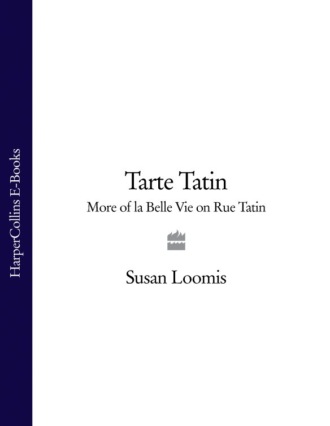
Полная версия
Tarte Tatin: More of La Belle Vie on Rue Tatin
I continued to schedule lunches that year, with the twelfth one in November, just over a year after our first. We looked back over the year in amazement. We’d actually realized a small part of our dream with very little publicity. True, the lunches were far from a goldmine, but they accomplished a great deal – we met very interesting people and were becoming accustomed to welcoming strangers into our house. I was having the time of my life creating menus and offering the best that I could possibly find, and watching people really enjoy it. And I was setting up a small infrastructure of people who could help me do everything from babysitting to serving at table. I considered it some of the most enjoyable on-the-job training I’d ever done.
We offered lunches from spring through to autumn for the next two years, as Michael finished the dining room and moved on to the huge task of building the kitchen. They continued to be interesting and enjoyable and they were leading us where we wanted to go, which was to the cooking school. It was taking on a real dimension. All I needed was a kitchen.
OLIVE COOKIES FROM THE DROME
Les Scourtins des Vieux Moulins
These sweet and salty bites are a very old recipe from Jean-Pierre Autrand, whose family produced olive oil at Les Vieux Moulin in Nyons, an ancient olive mill, until 1952. M. Autrand found this recipe in his family’s archives, updated it, and sells the results at the gift store adjacent to the olive mill. Les Vieux Moulins, 4, Promenade de la Digue, 26110 Nyons, France.
9 tbs (125g) unsalted butter, softened
3/4 cup (100g) confectioner’s sugar, sifted
1 tbs extra-virgin olive oil
1 1/4 cups (200g) all purpose flour
1 generous pinch of fine sea salt
1/2 cup (100g) cured olives, preferably from Nyons, pitted and coarsely chopped
1. Preheat the oven to 350°F (180°C). Line two baking sheets with parchment paper.
2. In a large bowl or the bowl of an electric mixer, cream the butter until it is soft and pale yellow. Mix in the sugar until blended, then drizzle in the olive oil and mix until combined. Add the flour and sea salt, and mix gently but thoroughly until the dough is smooth, then add the olives and mix until they are thoroughly incorporated into the dough.
3. Place a piece of waxed or parchment paper on a work surface, and place the dough in the middle. Cover it with another piece of waxed or parchment paper and roll out the dough until it is about 1/4-inch thick (1/2 cm) – (the dough is very sticky, and the paper makes it possible to roll out). Refrigerate the dough for at least 30 minutes, and up to 24 hours.
4. Cut out 2-inch rounds of dough and place them about 1/2 inch (1.3 cm) apart on the prepared baking sheets. Gather the trimmings into a ball and roll it into a 1-inch (2.5 cm) diameter log. Wrap well and refrigerate, and when you are ready to bake, cut off 1/4-inch (1/2 cm) thick rounds (this avoids over-rolling the dough).
5. Bake until the scourtins are golden, about 15 minutes. Remove from the oven and cool on wire racks.
Yield: about 34 scourtins
ORANGE WINE
Vin d’Orange
This wine is so simple to make, and to enjoy! Be sure to use organic oranges, and make this in the winter when the fruit is at its best. Though this wine is very drinkable after four weeks in the bottle, it mellows with age. I make it one year to serve the next, and suggest you do the same.
10 good-size oranges, preferably organic and well scrubbed
8 cups (2 1) dry white wine, such as Sancerre
2 cups (500 ml) pure fruit alcohol, or vodka
1 vanilla bean
1 tbs arabica coffee beans
2 cups minus 2 tbs (375 g) sugar
1. Peel the oranges right down to the fruit, including the pith. Put the fruit aside for another use.
2. Place the skins with the pith in a large nonreactive pot or bowl. Add the wine, vodka, vanilla bean, coffee beans, and half the sugar. Stir.
3. Caramelize the remaining sugar: place the sugar in a small heavy saucepan over medium-high heat. The sugar will melt and begin to bubble, then gradually liquefy, turning a golden colour. This will take about 7 minutes. Continue cooking, swirling the pan occasionally if it colours unevenly, until the sugar is a deep golden colour, like light molasses, about 5 minutes.
4. Remove the pan from the heat and pour the caramelized sugar into the orange mixture, scraping as much of the sugar as possible from the pan with a wooden spoon. The caramel will sizzle and send up steam, and it will instantly harden. Don’t be concerned – it will gradually dissolve. Loosely cover the bowl and let the mixture ripen in the bowl for two weeks, stirring it occasionally.
5. Strain the orange mixture through a sieve lined with a double layer of dampened cheesecloth or a dampened cotton tea towel. Discard the orange skins, the vanilla bean and the coffee beans and decant the liquid into sterilized bottles. Seal with corks. Let sit for at least 1 month before drinking.
About 2 1/2 quarts (2 1/2 1)
Конец ознакомительного фрагмента.
Текст предоставлен ООО «ЛитРес».
Прочитайте эту книгу целиком, купив полную легальную версию на ЛитРес.
Безопасно оплатить книгу можно банковской картой Visa, MasterCard, Maestro, со счета мобильного телефона, с платежного терминала, в салоне МТС или Связной, через PayPal, WebMoney, Яндекс.Деньги, QIWI Кошелек, бонусными картами или другим удобным Вам способом.



